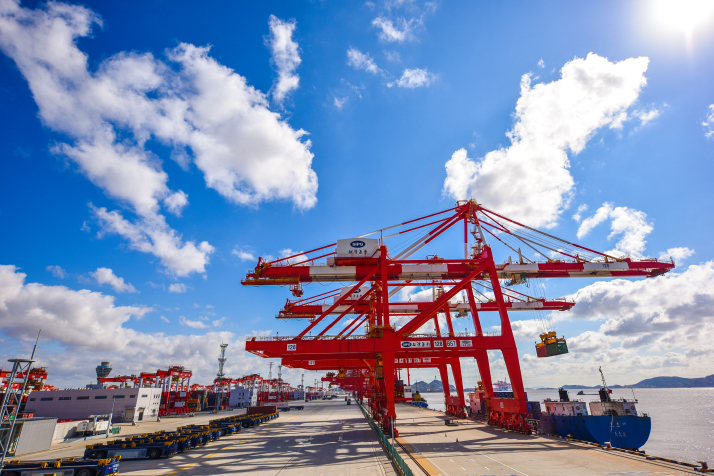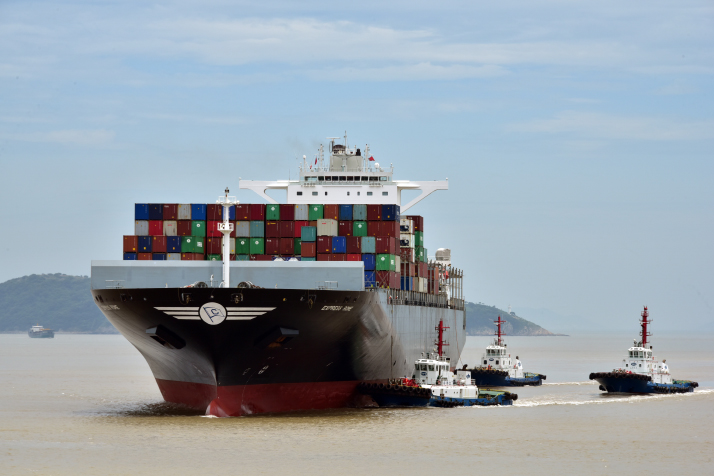|
||||||||||
| Home Nation World Business Opinion Lifestyle ChinAfrica Multimedia Columnists Documents Special Reports |
|
||||||||||
| Home Nation World Business Opinion Lifestyle ChinAfrica Multimedia Columnists Documents Special Reports |
| ChinAfrica |
| Smart Operation |
| The automated container terminal at Shanghai's Yangshan Port features higher efficiency, better work conditions |
| By Ge Lijun | VOL.12 February ·2020-02-13 |

A crane hoists a container in the automated container terminal at Yangshan Deep-water Port in Shanghai (WEI YAO)
Yangshan Port, located in Shanghai, looks like something straight out of a futuristic science-fiction movie. While giant cranes lift and move containers around, gantry cranes work tirelessly in perfect coordination. All of this is done without human intervention or supervision on the ground. It is a machine's world and a normal day at Yangshan, the world's largest automated container terminal in terms of scale and size.
Since the 1990s, container throughput in the port of Shanghai has been steadily increasing. However, the port's shallow-water depth was hindering its plans for future development. In order to raise its international competitiveness, Shanghai needed to find a new deep-water berth. Yangshan Island, about 30 km from the metropolis, met the criteria.
Connected to the mainland by the Donghai Bridge, the deep-water port of Yangshan was inaugurated on December 10, 2005, and the port's Phase IV Project was commissioned on the same day exactly 12 years later. This fully automated container terminal now occupies an area of 2.23 million square meters, with a coastline of 2,350 meters. By December 10, 2019, over a span of two years since it went into operation, the terminal had recorded 5.22 million TEUs of accumulative cargos. The annual container throughput of the port is envisaged to eventually reach 6.3 million TEUs, making Shanghai a metropolis with the largest container port in the world.
Breaking with tradition
"I've been a crane operator for 14 years. I never expected to be able to work in an air-conditioned room behind a computer," said Gu Jihan, sitting in Yangshan Port's central control room.
The control room is located in a modern tower at the end of the quay. Here, workers can remotely control every aspect of the operations. Gu sits at his desk in front of six screens showing live images of cranes and a computer displays various data. By moving the two joysticks in front of him, he gently hoists a container. "It looks just like a video game," he said.
His crane moves the container onto a transfer platform. A gantry crane then takes the container to an automated guided vehicle. The entire operation takes less than two minutes. Guided by more than 60,000 magnetic nails on the ground, the vehicle then transports the container to the marshalling area. "The whole process is set in advance and is carried out through automated procedures," Sun Jinyu, Deputy General Manager of Shangdong Container Terminal Branch of Shanghai International Port Group, told ChinAfrica.
According to Sun, all operations at Yangshan Port, including container handling in the dock and marshalling areas and horizontal transport, are automated. No employees are required on the ground.
As a crane operator, Gu is very satisfied with the new system. For him, the biggest change brought about by automation is the improvement in his working conditions. "Before, I had to work on the cranes. In the summer, I used to sweat as I climbed to my crane cab, which was very small," he recalled. Back then he was a manual worker; now, he is a white-collar worker.
According to Sun, the Yangshan Deep-water Port Phase IV Project has reduced labor costs by 70 percent. "In addition, automation has also minimized the impact of human factors in terms of stability and safety," he added.
Yangshan Port is not only smart, but also green: The automated container terminal has achieved its goal of zero emission. All major container-handling machines are electrified, eliminating emissions and reducing noise pollution. Optimization of container handling and widespread adoption of energy-feedback technology will also reduce energy consumption.

Designed in China, the Yangshan Deep-Water Port Phase IV Project connects the world (CNSPHOTO)
Designed in China
The construction of the port itself and of its control system, both hardware and software, is entirely based on Chinese technology. Jin Xin, a young man born in the 1980s who is now Director of the R&D Department at Shanghai Zhenhua Port Machinery Group, led the design of the intelligent control system.
In July 2015, Zhenhua Port Machinery Group signed a contract with the Yangshan Deep-water Port Phase IV Project. Jin was appointed by his company as the software technology leader for the project. In early 2017, in order to carry out the new tasks required for the opening of the port, he and his team spent an entire month on Yangshan Island, working from early morning until late at night. "As there was no previous benchmark experience in this field in China, we created solutions ourselves to provide a solid reference for future projects," he explained.
"Prior to the opening of Yangshan Port, there had been only three fully automated terminals in operation around the world, one in Long Beach of the United States, and the other two respectively in Xiamen and Qingdao of China. While Chinese-made equipment was used in all three terminals, the key technology related to their operation management and control system was provided by a German company. In order to achieve a breakthrough, we had to innovate from the start," said Qin Tao, Software Project Manager in the Yangshan Deep-water Port Phase IV Project.
According to Fang Huaijin, Vice President of Shanghai International Port Group, hi-tech solutions will now be widely used to create "a ripple effect." He revealed that another container terminal at the port of Shanghai is now in the process of being automated.
China Communications Construction has undertaken the design and construction of almost all docks in China. Globally, the company has built more than 100 deep-water terminals in Asia, the Middle East, South America and Africa, such as the port of Abidjan in Côte d'Ivoire, Port Sudan in Sudan, and the port of Kribi in Cameroon.
On November 3, 2019, on the last day of his visit to China, South African Vice President David Mabuza visited Yangshan Port. Thanks to its unique geographical position, South Africa has a number of important world-class ports. Mabuza intends to promote cooperation between the two countries in this area. "There is no doubt that both countries have great potential for cooperation in the area of ports," he said.
According to Fang, the port is currently looking for opportunities along the Maritime Silk Road, and the Yangshan Deep-water Port Phase IV Project will serve as a reference for other ports wishing to take part in the Belt and Road Initiative. Currently, Yangshan Port is linked to more than 500 ports worldwide.
(Comments to glj@chinafrica.cn)
| About Us | Contact Us | Advertise with Us | Subscribe |
| Copyright Beijing Review All rights reserved 京ICP备08005356号-5 京公网安备110102005860号 |